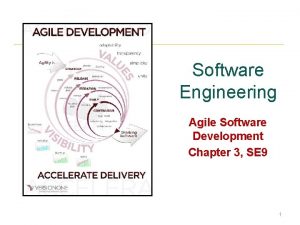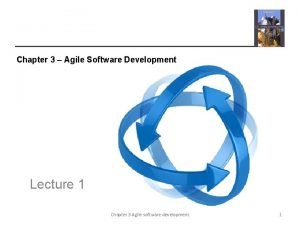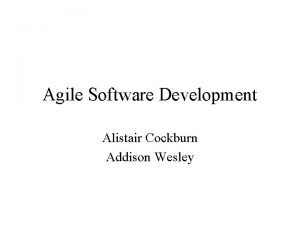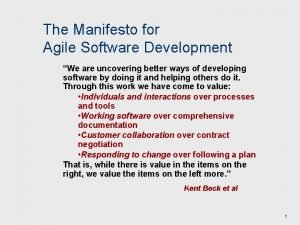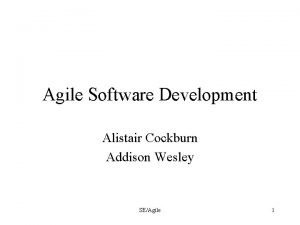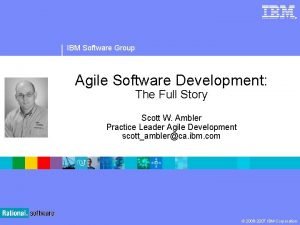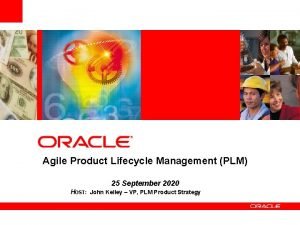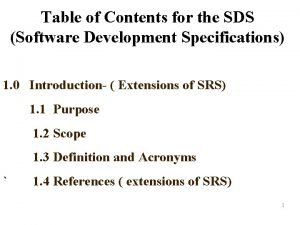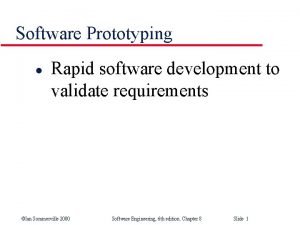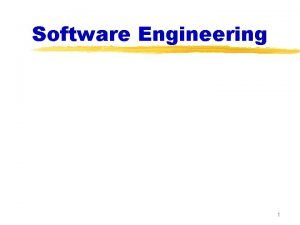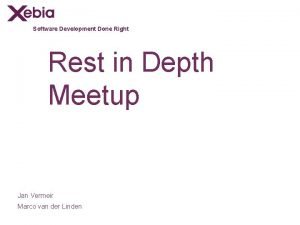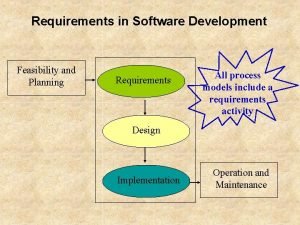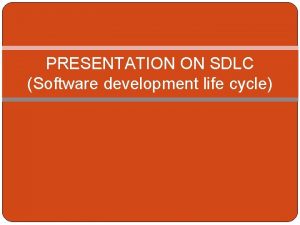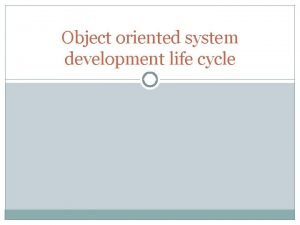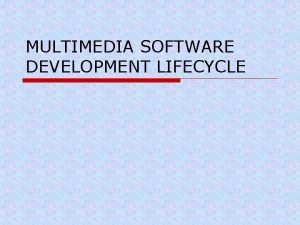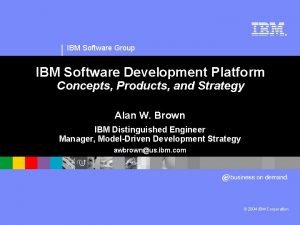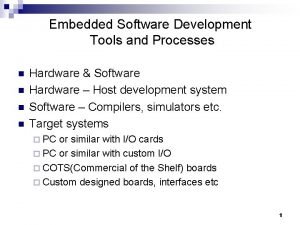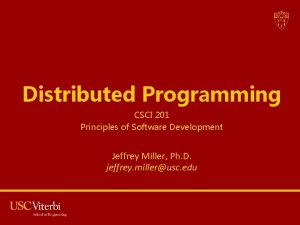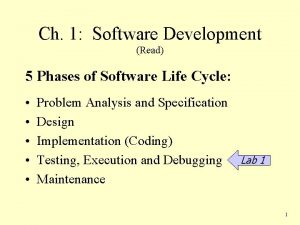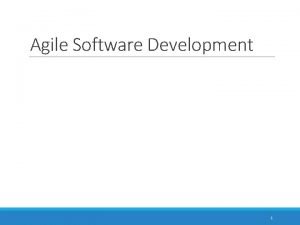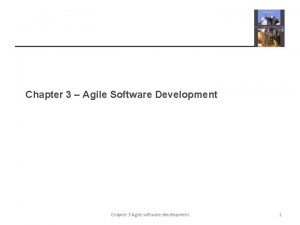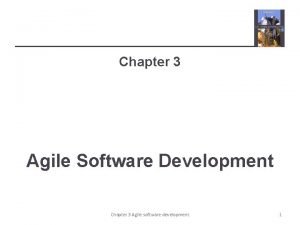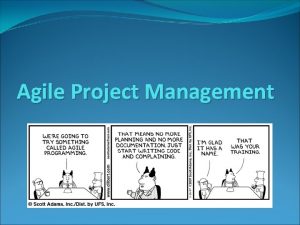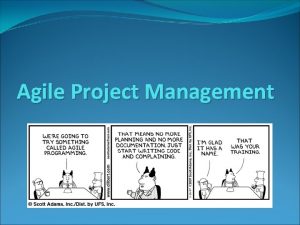Chapter 3 Agile Software Development Chapter 3 Agile













































- Slides: 45

Chapter 3 – Agile Software Development Chapter 3 Agile software development 1

Topics covered � Agile methods � Agile development technique � Agile project management � Scaling agile methods Chapter 3 Agile software development 2

Agile Methods Chapter 3 Agile software development 3

Rapid software development � Rapid development and delivery is now often the most important requirement for software systems ◦ Businesses operate in a fast –changing requirement and it is practically impossible to produce a set of stable software requirements ◦ Software has to evolve quickly to reflect changing business needs. � Plan-driven development does not meet these fast -changing requirements. � Thus, agile development methods emerged in 1990 s to radically reduced delivery time for working software systems. Chapter 3 Agile software development 4

Agile development � Program specification, design and implementation are inter-leaved(in parallel). � The system is developed as a series of versions or increments with stakeholders involved in version specification and evaluation � Frequent delivery of new versions for evaluation � Extensive tool support (e. g. automated testing tools) used to support development. � Minimal documentation – focus on working code Chapter 3 Agile software development 5

Plan-driven and agile specification Chapter 3 Agile software development 6

Plan-driven and agile development � Plan-driven development ◦ A plan-driven approach to software engineering is based around separate development stages with the outputs to be produced at each of these stages planned in advance. ◦ Example : waterfall model � Agile development ◦ Specification, design, implementation and testing are inter-leaved and the outputs from the development process are decided through a process of negotiation during the software development process. Chapter 3 Agile software development 7

Agile methods � Dissatisfaction with the overheads involved in software design methods of the 1980 s and 1990 s led to the creation of agile methods. These methods: ◦ Focus on the code rather than the design ◦ Are based on an iterative approach to software development ◦ Are intended to deliver working software quickly and evolve this quickly to meet changing requirements. � The aim of agile methods is to reduce overheads in the software process (e. g. by limiting documentation) and to be able to respond quickly to changing requirements without excessive rework. Chapter 3 Agile software development 8

Agile manifesto � We are uncovering better ways of developing software by doing it and helping others do it. Through this work we have come to value: ◦ Individuals and interactions over processes and tools Working software over comprehensive documentation Customer collaboration over contract negotiation Responding to change over following a plan � That is, while there is value in the items on the right, we value the items on the left more. Chapter 3 Agile software development 9

The principles of agile methods Principle Description Customer involvement Customers should be closely involved throughout the development process. Their role is provide and prioritize new system requirements and to evaluate the iterations of the system. Incremental delivery The software is developed in increments with the customer specifying the requirements to be included in each increment. People not process The skills of the development team should be recognized and exploited. Team members should be left to develop their own ways of working without prescriptive processes. Embrace change Expect the system requirements to change and so design the system to accommodate these changes. Maintain simplicity Focus on simplicity in both the software being developed and in the development process. Wherever possible, actively work to eliminate complexity from the system. Chapter 3 Agile software development 10

Agile method applicability � Product development where a software company is developing a small or mediumsized product for sale. � Custom system development within an organization, where there is a clear commitment from the customer to become involved in the development process and where there are not a lot of external rules and regulations that affect the software. � Example: a small custom design system for small company. Chapter 3 Agile software development 11

Agile Development Technique Chapter 3 Agile software development 12

Extreme programming � Perhaps the best-known and most widely used agile method. � Extreme Programming (XP) takes an ‘extreme’ approach to iterative development. ◦ New versions may be built several times per day; ◦ Increments are delivered to customers every 2 weeks; ◦ All tests must be run for every build and the build is only accepted if tests run successfully. Chapter 3 Agile software development 13

The extreme programming release cycle Chapter 3 Agile software development 14

Extreme programming practices (a) Principle or practice Description Incremental planning Requirements are recorded on story cards and the stories to be included in a release are determined by the time available and their relative priority. The developers break these stories into development ‘Tasks’. Small releases The minimal useful set of functionality that provides business value is developed first. Releases of the system are frequent and incrementally add functionality to the first release. Simple design Enough design is carried out to meet the current requirements and no more. Test-first development An automated unit test framework is used to write tests for a new piece of functionality before that functionality itself is implemented. Refactoring All developers are expected to refactor the code continuously as soon as possible code improvements are found. This keeps the code simple and maintainable. Chapter 3 Agile software development 15

Extreme programming practices (b) Pair programming Developers work in pairs, checking each other’s work and providing the support to always do a good job. Collective ownership The pairs of developers work on all areas of the system, so that no islands of expertise develop and all the developers take responsibility for all of the code. Anyone can change anything. Continuous integration As soon as the work on a task is complete, it is integrated into the whole system. After any such integration, all the unit tests in the system must pass. Sustainable pace Large amounts of overtime are not considered acceptable as the net effect is often to reduce code quality and medium term productivity On-site customer A representative of the end-user of the system (the customer) should be available full time for the use of the XP team. In an extreme programming process, the customer is a member of the development team and is responsible for bringing system requirements to the team for implementation. Chapter 3 Agile software development 16

Key XP Practices � Extreme programming has a technical focus and is not easy to integrate with management practice in most organizations. � Consequently, while agile development uses practices from XP, the method as originally defined is not widely used. � Key practices ◦ User stories for specification ◦ Refactoring ◦ Test-first development ◦ Pair programming Chapter 3 Agile software development 17

User Stories for requirements � In XP, a customer or user is part of the XP team and is responsible for making decisions on requirements. � User requirements are expressed as scenarios or user stories. � These are written on cards and the development team break them down into implementation tasks. These tasks are the basis of schedule and cost estimates. � The customer chooses the stories for inclusion in the next release based on their priorities and the schedule estimates. Chapter 3 Agile software development 18

A ‘prescribing medication’ story Chapter 3 Agile software development 19

Examples of task cards for prescribing medication Chapter 3 Agile software development 20

Refactoring(making changes) � Programming team look for possible software improvements. � Changes are easier to make because the code is well-structured and clear. � Examples of refactoring: ◦ Re-organization of a class hierarchy to remove duplicate code. ◦ Tidying up and renaming attributes and methods to make them easier to understand. Chapter 3 Agile software development 21

Test-first development � Testing is central to XP and XP has developed an approach where the program is tested after every change has been made. � Writing tests before code clarifies the requirements to be implemented. � Tests are written as programs rather than data so that they can be executed automatically. The test includes a check that it has executed correctly. ◦ Usually relies on a testing framework such as Junit. � All previous and new tests are run automatically when new functionality is added, thus checking that the new functionality has not introduced errors. Chapter 3 Agile software development 22

Customer involvement � The role of the customer in the testing process is to help develop acceptance tests for the stories that are to be implemented in the next release of the system. � The customer who is part of the team writes tests as development proceeds. All new code is therefore validated to ensure that it is what the customer needs. � However, people adopting the customer role have limited time available and so cannot work fulltime with the development team. They may feel that providing the requirements was enough of a contribution and so may be reluctant to get involved in the testing process. Chapter 3 Agile software development 23

Test case description for dose checking Chapter 3 Agile software development 24

Pair programming � In XP, programmers work in pairs, sitting together to develop code. � This helps develop common ownership of code and spreads knowledge across the team. � It serves as an informal review process as each line of code is looked at by more than 1 person. � It encourages refactoring as the whole team can benefit from this. � Measurements suggest that development productivity with pair programming is similar to that of two people working independently. Chapter 3 Agile software development 25

Advantages of pair programming � It supports the idea of collective ownership and responsibility for the system. ◦ Individuals are not held responsible for problems with the code. Instead, the team has collective responsibility for resolving these problems. � It acts as an informal review process because each line of code is looked at by at least two people. � It helps support refactoring, which is a process of software improvement. ◦ Where pair programming and collective ownership are used, others benefit immediately from the refactoring so they are likely to support the process. Chapter 3 Agile software development 26

Agile Project Management Chapter 3 Agile software development 27

Scrum � The Scrum approach is a general agile method but its focus is on managing iterative development rather than specific agile practices. � There are three phases in Scrum. ◦ The initial phase is an outline planning phase where you establish the general objectives for the project and design the software architecture. ◦ This is followed by a series of sprint cycles, where each cycle develops an increment of the system. ◦ The project closure phase wraps up the project, completes required documentation such as system help frames and user manuals and assesses the lessons learned from the project. Chapter 3 Agile software development 28

The Scrum process Chapter 3 Agile software development 29

The Sprint cycle � Sprints are fixed length, normally 2– 4 weeks. They correspond to the development of a release of the system in XP. � The starting point for planning is the product backlog, which is the list of work to be done on the project. � The selection phase involves all of the project team who work with the customer to select the features and functionality to be developed during the sprint. Chapter 3 Agile software development 30

The Sprint cycle � Once these are agreed, the team organize themselves to develop the software. During this stage the team is isolated from the customer and the organization, with all communications channelled through the socalled ‘Scrum master’. � The role of the Scrum master is to protect the development team from external distractions. � At the end of the sprint, the work done is reviewed and presented to stakeholders. The next sprint cycle then begins. Chapter 3 Agile software development 31

Teamwork in Scrum � The ‘Scrum master’ is a facilitator who arranges daily meetings, tracks the backlog of work to be done, records decisions, measures progress against the backlog and communicates with customers and management outside of the team. � The whole team attends short daily meetings where all team members share information, describe their progress since the last meeting, problems that have arisen and what is planned for the following day. ◦ This means that everyone on the team knows what is going on and, if problems arise, can re-plan short-term work to cope with them. Chapter 3 Agile software development 32

Scrum benefits � The product is broken down into a set of manageable and understandable chunks. � Unstable requirements do not hold up progress. � The whole team have visibility of everything and consequently team communication is improved. � Customers see on-time delivery of increments and gain feedback on how the product works. � Trust between customers and developers is established and a positive culture is created in which everyone expects the project to succeed. Chapter 3 Agile software development 33

Scaling Agile Methods Chapter 3 Agile software development 34

Scaling agile methods � Agile methods have proved to be successful for small and medium sized projects that can be developed by a small co-located team. � It is sometimes argued that the success of these methods comes because of improved communications which is possible when everyone is working together. � Scaling up agile methods involves changing these to cope with larger, longer projects where there are multiple development teams, perhaps working in different locations. Chapter 3 Agile software development 35

Scaling out and scaling up � ‘Scaling up’ is concerned with using agile methods for developing large software systems that cannot be developed by a small team. � ‘Scaling out’ is concerned with how agile methods can be introduced across a large organization with many years of software development experience. � When scaling agile methods it is essential to maintain agile fundamentals ◦ Flexible planning, frequent system releases, continuous integration, test-driven development and good team communications. Chapter 3 Agile software development 36

Practical problems with agile methods � The informality of agile development is incompatible with the legal approach to contract definition that is commonly used in large companies. � Agile methods are most appropriate for new software development rather than software maintenance. Yet the majority of software costs in large companies come from maintaining their existing software systems. � Agile methods are designed for small co-located teams yet much software development now involves worldwide distributed teams. Chapter 3 Agile software development 37

Agile methods and software maintenance � Most organizations spend more on maintaining existing software than they do on new software development. So, if agile methods are to be successful, they have to support maintenance as well as original development. � Two key issues: ◦ Are systems that are developed using an agile approach maintainable, given the emphasis in the development process of minimizing formal documentation? ◦ Can agile methods be used effectively for evolving a system in response to customer change requests? � Problems may arise if original development team cannot be maintained. Chapter 3 Agile software development 38

Large systems development Large systems are usually collections of separate, communicating systems, where separate teams develop each system. Frequently, these teams are working in different places, sometimes in different time zones. � Large systems are ‘brownfield systems’, that is they include and interact with a number of existing systems. Many of the system requirements are concerned with this interaction and so don’t really lend themselves to flexibility and incremental development. � Where several systems are integrated to create a system, a significant fraction of the development is concerned with system configuration rather than original code development. � Chapter 3 Agile software development 39

Large system development � Large systems and their development processes are often constrained by external rules and regulations limiting the way that they can be developed. � Large systems have a long procurement and development time. It is difficult to maintain coherent teams who know about the system over that period as, inevitably, people move on to other jobs and projects. � Large systems usually have a diverse set of stakeholders. It is practically impossible to involve all of these different stakeholders in the development process. Chapter 3 Agile software development 40

Scaling up to large systems For large systems development, it is not possible to focus only on the code of the system. You need to do more up-front design and system documentation � Cross-team communication mechanisms have to be designed and used. This should involve regular phone and video conferences between team members and frequent, short electronic meetings where teams update each other on progress. � Continuous integration, where the whole system is built every time any developer checks in a change, is practically impossible. However, it is essential to maintain frequent system builds and regular releases of the system. � Chapter 3 Agile software development 41

Scaling out to large companies Project managers who do not have experience of agile methods may be reluctant to accept the risk of a new approach. � Large organizations often have quality procedures and standards that all projects are expected to follow and, because of their bureaucratic nature, these are likely to be incompatible with agile methods. � Agile methods seem to work best when team members have a relatively high skill level. However, within large organizations, there are likely to be a wide range of skills and abilities. � There may be cultural resistance to agile methods, especially in those organizations that have a long history of using conventional systems engineering processes. � Chapter 3 Agile software development 42

Key Points Chapter 3 Agile software development 43

Key points � � � Agile methods are incremental development methods that focus on rapid development, frequent releases of the software, reducing process overheads and producing highquality code. They involve the customer directly in the development process. The decision on whether to use an agile or a plan-driven approach to development should depend on the type of software being developed, the capabilities of the development team and the culture of the company developing the system. Extreme programming is a well-known agile method that integrates a range of good programming practices such as frequent releases of the software, continuous software improvement and customer participation in the development team. Chapter 3 Agile software development 44

Key points �A particular strength of extreme programming is the development of automated tests before a program feature is created. All tests must successfully execute when an increment is integrated into a system. � The Scrum method is an agile method that provides a project management framework. It is centred round a set of sprints, which are fixed time periods when a system increment is developed. � Scaling agile methods for large systems is difficult. Large systems need up-front design and some documentation. Chapter 3 Agile software development 45
 Chapter 3 agile software development
Chapter 3 agile software development Chapter 3 agile software development
Chapter 3 agile software development Chapter 3 agile software development
Chapter 3 agile software development Microsoft solution framework
Microsoft solution framework Agile embedded software development
Agile embedded software development Rock climbing cockburn
Rock climbing cockburn Agile software development capitalization
Agile software development capitalization Manifesto for agile software development
Manifesto for agile software development Agile iso 9001
Agile iso 9001 Agile software development alistair cockburn
Agile software development alistair cockburn Ibm agile development
Ibm agile development Dilbert agile
Dilbert agile Agile model driven development amdd
Agile model driven development amdd Eligasi
Eligasi Scrum for beginners
Scrum for beginners Agile java development
Agile java development Agile development ruby
Agile development ruby Apa itu agile development
Apa itu agile development Agile product development for mass customization
Agile product development for mass customization Accenture delivery methods (adm)
Accenture delivery methods (adm) Rapid agile development
Rapid agile development Agile product lifecycle management software
Agile product lifecycle management software Agile view of process in software engineering
Agile view of process in software engineering Historical development of community work
Historical development of community work Development that ended much development crossword
Development that ended much development crossword Radial line development
Radial line development Ivar nnn
Ivar nnn Tsp/psp software development process
Tsp/psp software development process Sds software engineering
Sds software engineering Rapid software prototyping
Rapid software prototyping Exploratory style vs modern software development
Exploratory style vs modern software development Hateoas resources
Hateoas resources Requirement analysis definition
Requirement analysis definition 4 p's of management spectrum
4 p's of management spectrum Software life cycle ppt
Software life cycle ppt History of software development life cycle
History of software development life cycle Object oriented system development life cycle in ooad
Object oriented system development life cycle in ooad Multimedia software development
Multimedia software development Ibm software development platform
Ibm software development platform Software development center argentina
Software development center argentina Embedded software development tools
Embedded software development tools Project plan presentation
Project plan presentation 201 principles of software development pdf
201 principles of software development pdf Odw 5e ch05 arrange the software development life cycle
Odw 5e ch05 arrange the software development life cycle Software development t shirt sizing
Software development t shirt sizing Advanced software development
Advanced software development

